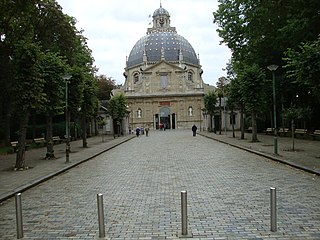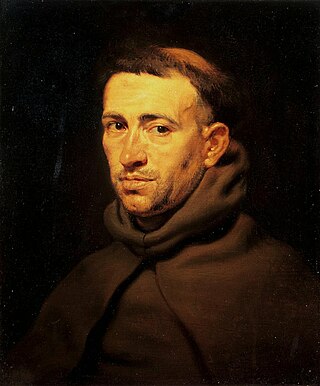
Scherpenheuvel-Zichem is a city and municipality located in the province of Flemish Brabant, Flemish Region, Belgium, encompassing the towns of Averbode, Messelbroek, Okselaar, Scherpenheuvel, Schoonderbuken, Keiberg, Kaggevinne, Testelt and Zichem. On January 1, 2020, Scherpenheuvel-Zichem had a total population of 23,135. The total area is 50.50km2 which gives a population density of 458.1 inhabitants per km2.

Justus Lipsius was a Flemish Catholic philologist, philosopher, and humanist. Lipsius wrote a series of works designed to revive ancient Stoicism in a form that would be compatible with Christianity. The most famous of these is De Constantia. His form of Stoicism influenced a number of contemporary thinkers, creating the intellectual movement of Neostoicism. He taught at the universities in Jena, Leiden, and Leuven.

A Joyous Entry is the official name used for the ceremonial royal entry, the first official peaceable visit of a reigning monarch, prince, duke or governor into a city, mainly in the Duchy of Brabant or the County of Flanders and occasionally in France, Luxembourg, Hungary, or Scotland, usually coinciding with recognition by the monarch of the rights or privileges to the city and sometimes accompanied by an extension of them.

Wenceslas Cobergher, sometimes called Wenzel Coebergher, was a Flemish Renaissance architect, engineer, painter, antiquarian, numismatist and economist. Faded somewhat into the background as a painter, he is chiefly remembered today as the man responsible for the draining of the Moëres on the Franco-Belgian border. He is also one of the fathers of the Flemish Baroque style of architecture in the Southern Netherlands.

The Basilica of Our Lady of Scherpenheuvel is a Roman Catholic parish church and minor basilica in Scherpenheuvel-Zichem, Belgium. The church was consecrated in 1627 and raised to the status of a minor basilica in 1922. It is reputedly the most frequently visited shrine of pilgrimage in Belgium. While the cult on the Scherpenheuvel is older, its present architectural layout and its enduring importance are due to the patronage of the Archdukes Albert and Isabella and the Counter-Reformation.
Jean-Baptiste Gramaye was an early modern historian of the Southern Netherlands. He studied law and became a professor at Leuven University. Later he was employed as court historian by Albert VII, Archduke of Austria. For five months in 1619 he was a prisoner in Barbary, an experience that changed the focus of his scholarship from the Low Countries to Africa.
Robert Chambers (1571–1628), was a Catholic priest from Yorkshire.
Rutger Velpius was a 16th- and 17th-century printer and bookseller. He was the first printer in the city of Mons, and later became printer to the court in Brussels. His career coincided closely with the first decades of the Dutch Revolt
Arnout Coninx (1548–1617) was a printer and bookseller in the city of Antwerp from 1579 until his death in 1617. In 1586 he was fined for unlicensed printing, and in 1591 he was investigated for selling forbidden books. When the city of Antwerp had been reconquered for Philip II of Spain in 1585, Protestants had been given four years to settle their affairs and leave or be reconciled to the Catholic Church. Coninx waited until 1590, after the deadline had passed, to register his conversion to Catholicism.

Jan Mommaert was the name of two 17th-century printers in Brussels, father and son. Between the dates of their activity, Martine van Straeten operated a printing house under the name Widow of Jan Mommaert.
Jan Thieullier was a Flemish poet, residing in Mechelen, about whom very little is known.
Events from the 1580s in the Spanish Netherlands and Prince-bishopric of Liège.

Adrianus or Adriaan van Meerbeeck (1563–1627) was a writer and translator from Antwerp.

Andres de Soto or Andreas a Soto (1552/3–1625) was a Franciscan preacher and spiritual writer, confessor to the Infanta Isabella Clara Eugenia.
Nicolas de Montmorency, count of Estaires, was an office holder and spiritual author in the Spanish Netherlands.
Jan van Blitterswyck was a Carthusian writer and translator in the Spanish Netherlands.
Maximilien de Wignacourt, alternatively Vignacourt or Vignacurtius (1560–1620) was a writer in Latin and French in the Spanish Netherlands.
Events in the year 1601 in the Spanish Netherlands and Prince-bishopric of Liège.
Cornelius Thielmans was a Franciscan hagiographer from the Habsburg Netherlands.








